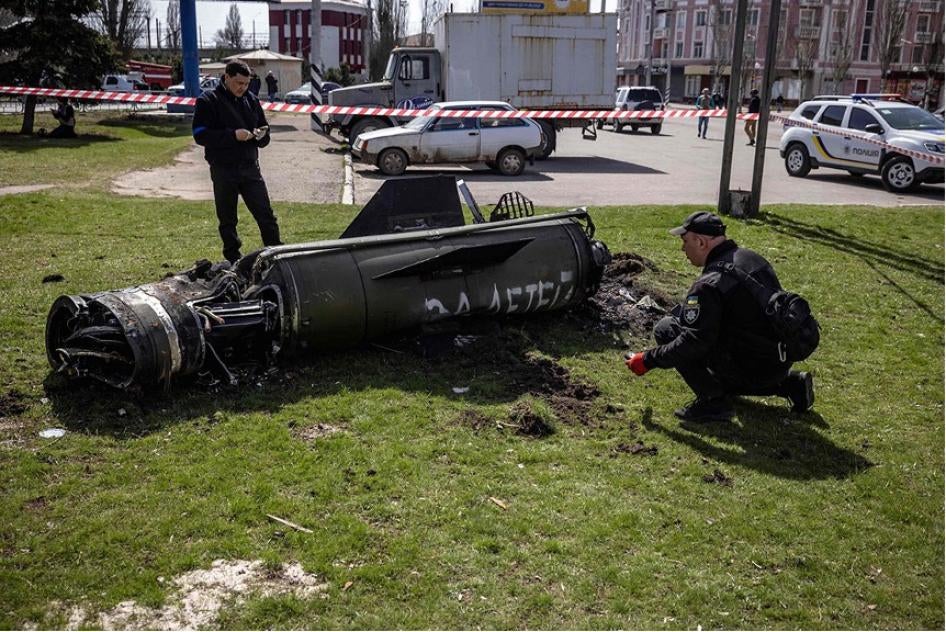(Kyiv, February 21, 2023) – Russia’s cluster munition strike on the crowded Kramatorsk train station in eastern Ukraine in April 2022 killed dozens of civilians in violation of the laws of war, and was an apparent war crime, Human Rights Watch and SITU Research said in a report and video released today.
“Death at the Station: Russian Cluster Munition Attack in Kramatorsk,” the result of a new in-depth investigation, reconstructs through text and video the sequence of events surrounding Russia’s unlawful attack in Kramatorsk. On the morning of April 8, several hundred civilians were waiting at the station when a ballistic missile equipped with a cluster munition warhead exploded and released dozens of bomblets, or submunitions, killing at least 58 civilians and injuring over 100 others. The Russian commanders responsible for ordering the attack, which used an inherently indiscriminate weapon in a well-known major evacuation hub, should be investigated and held accountable.
“Russia’s unlawful and appalling attack on the Kramatorsk train station killed and wounded civilians desperately trying to flee the fighting,” said Richard Weir, senior crisis and conflict researcher at Human Rights Watch. “The brutal effects of cluster munitions on crowds of people should be a clarion call for Russian forces to stop using these banned weapons.”
Human Rights Watch visited the city of Kramatorsk, in the Donetska region, from May 14 to 24 to investigate the attack and its aftermath. Researchers interviewed 69 people, including survivors of the attack, relatives of those killed, first responders, doctors, hospital staff, government officials, and Ukrainian government investigators. Human Rights Watch and SITU Research analyzed over 200 videos and photographs and conducted a spatial and temporal analysis of the attack. Researchers also reviewed satellite imagery and inspected a former Russian military position near Kunie village in the Kharkivska region, a possible launch location for the attack.
In the days before the attack, tens of thousands of people from across the eastern Donbas area traveled through the Kramatorsk train station as part of an evacuation encouraged and facilitated by local authorities. On the morning of the attack, more than 500 civilians were gathered at the station with their belongings, awaiting trains to take them to relative safety in western Ukraine.
The ballistic missile exploded high above the station at 10:28 a.m., releasing dozens of submunitions. These struck the ground and detonated, killing and wounding scores of people waiting at the station, including children and older people. A woman waiting on the train platform with her family described the chaos of the moment: “When the first explosions happened, we didn’t understand what it was. … When people started to scream, I understood, it was something terrible. … [W]e fell to the ground. But my mother-in-law [age 72] didn’t react fast enough and kept sitting. One of her legs was torn away, the other one was broken, and then she died.”
First responders, station volunteers, and ordinary citizens provided first aid, in some cases attempting to stop serious bleeding with diapers before medical equipment reached the scene. An ambulance driver, who arrived a few minutes after the attack, said: “People were crying all around. Very, very painful cries. I heard the crying of people who had 20 to 40 seconds left to live. I heard the last cries before death. I saw limbs, children’s limbs on the ground.”
Human Rights Watch analyzed photographs of the rocket motor and guidance section of the weapon, which struck about 50 meters southwest of the station’s main entrance, and identified the weapon as a 9M79K-1 series Tochka-U ballistic missile. Human Rights Watch also examined submunition remnants and fragmentation at 32 impact sites and positively identified the 9N24 submunition based on an intact tail-fin assembly, pre-formed metal fragments, and discrete pieces of the submunitions’ nose-section that researchers found onsite.
The Tochka-U delivers the 9N24 submunitions in a 9N123K cluster munition warhead. The cluster munition warhead contains 50 fragmentation submunitions. According to the Russian manufacturer, each 9N24 submunition contains 1.45 kilograms of explosives, and shatters into approximately 316 uniform-sized fragments. This meant that approximately 15,800 lethal metal fragments were dispersed at the station and the surrounding area.
Both Russia and Ukraine stockpile the Tochka ballistic missile equipped with a cluster munition warhead. Russia denied that it attacked the Kramatorsk train station and has repeatedly claimed that its forces no longer use the Tochka-U missile system. Human Rights Watch, however, found evidence that Russian forces had Tochka launch vehicles, its associated missile transport equipment, and Tochka missiles in the area around Kunie village – northwest of Kramatorsk and within the 120-kilometer firing range of the train station – around the time of the attack, and that Russian forces regularly launched attacks from positions around Kunie during this period.
Cluster munitions are banned under international law because of their widespread indiscriminate effect and long term danger to civilians. Cluster munitions typically explode in the air and send dozens, even hundreds, of submunitions over hundreds of meters. Submunitions often fail to explode on initial impact, leaving duds that act like landmines.
Neither Russia nor Ukraine is among the 110 countries party to the Convention on Cluster Munitions, which comprehensively prohibits cluster munitions. Human Rights Watch has documented Russia’s repeated use of cluster munitions in the conflict. Ukrainian forces appear to have used cluster munitions rockets on several occasions.
“Cluster munitions are, by definition, indiscriminate. Russia’s use of this weapon on the Kramatorsk train station, while it was a publicly known hub for civilian evacuations, is horrifying,” said Brad Samuels, director of SITU Research. “All countries should unequivocally condemn this attack and any other use of cluster munitions. The attack should be investigated and those responsible brought to justice.”








